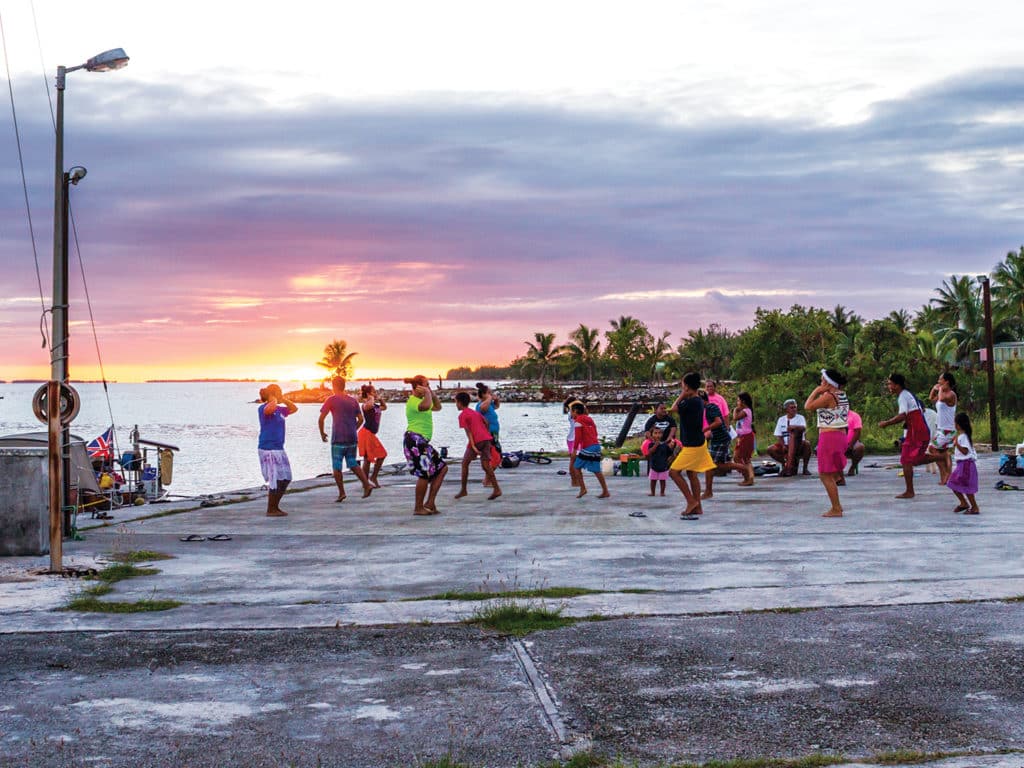
July is festival month in French Polynesia. Outrigger canoe racing, artisan fairs, food stalls and, most of all, dancing and dance competitions. Traditional dance, called Ote’a, is very much alive throughout the South Pacific, and arguably reaches its pinnacle at the Heiva i Tahiti, the competition that draws dancers from all over Polynesia every July. The dances—and the stunning costumes—are highlights of a voyage across the Pacific: Indeed, many sailors time their cruising to reach Tahiti at some point during the Heiva. But all over the French Polynesian archipelagos, smaller Heiva festivals take place featuring local dance troupes.
Rather than heading to Tahiti itself, my husband, Seth, and I had chosen instead to spend most of our cruising season in the Tuamotus, the immense chain of atolls that stretches southeast to northwest between the Marquesas and the Society Islands, of which Tahiti is a part. The atolls—with their clear lagoons, coral walls and swarms of sharks—are a wonderland for scuba divers, which was the major draw for the two of us. But we also love traditional Polynesian dance and song, and so were delighted to find a Heiva already swinging into action upon our arrival at the end of June. Women were decorating the town square, weaving palm fronds over the facades of the post office, the town hall and a series of pop-up restaurants that had been constructed for the holiday month to come. The restaurateurs were pasting up menus featuring poisson cru in different variations, as well as chicken, pork, and sundry cakes and pastries. After stretching our legs around the village and surrounding coconut groves, we made our way back to our cold-molded wooden cutter, Celeste, where it was tied up, secure and calm after the passage, to an old wharf.
We hadn’t been sitting over our sundowners long before the steady rhythm of a drum, loud and close, broke us out of our sunset reveries. Swiveling around to face the wharf, we saw two musicians seated on plastic chairs before their lovely wooden drums. Another musician next to them was just taking up his ukulele and soon began to sing. People trickled in from the paths that led to the wharf from town. Women, girls and boys in their casual everyday clothes—T-shirts, athletic shorts, skirts and pareus—shook off their flip-flops and took up positions in three lines facing the musicians. And started to dance. The girls swung their hips in the classic Polynesian style, made famous in Hawaiian hula, and the boys made a characteristic knocking motion with their knees. They stepped forward and back, turned and turned again, changing positions in the lines. Their arms and hands formed graceful circles and curves in the air. They knelt and then stood again. Often they were out of sync or someone went to the wrong place. Then the young woman who was clearly the teacher would call out to correct them, or walk over to show them.
They all reappeared on the wharf the next evening, and every evening thereafter, practicing for the big event, the competition that would crown the local Heiva.
She made them go over and over the toughest sections, practicing, practicing, until they were together in the choreography. Sometimes she spoke the local language and sometimes French, reminding them several times to pay attention, that the competition was taking place in only three weeks. The sun went down below the palms and then below the sea. The sky turned deep blue; the brightest stars appeared; darkness fell; the dancers dispersed, laughing and chatting; and the musicians picked up their instruments and chairs, and wandered back up the tracks to the village.
They all reappeared on the wharf the next evening, and every evening thereafter, practicing for the big event, the competition that would crown the local Heiva. Day by day they got better, in closer formation, in more tightly choreographed movement, until it was nearly impossible to focus on just one dancer because watching the whole troupe together was the true effect. Seth and I got to know the songs that the ukulele player sang, even if we understood only a few of the Polynesian lyrics. We loved the singing, but the fast, dynamic dancing that accompanied the drum-only numbers was our favorite. We got to know the dancers, especially the children, who started to arrive early so they could come on board Celeste and visit with us. The girls discovered our wedding album and pored over it; the boys found endless amusement critiquing Seth’s fishing lures and swapping fishing tales. They taught us the local names for things, especially fish, and they all urged us to stay and watch their competition.
In the end, we did. We stayed three weeks in that one spot, every night watching the sun go down behind the dancers. The competition itself took place in the decorated town square, refreshed that day with new, green palm weaving. “Our” troupe went first, decked out in beautiful costumes sewn from colorful pareus, and decorated with shells and gleaming dark mother-of-pearl. We cheered them on and hummed along to the now-familiar songs. After them came another troupe in equally fabulous costumes, topped with immense woven headdresses. They were just as good, in our opinion, but we couldn’t help but be pleased when the judges came down in favor of our troupe, whom we’d befriended over our three weeks at the wharf.








